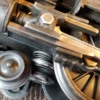IMO the growl is typical, not a problem there. Your '50 model probably has more mileage on it. It was built before "peak train" and probably saw a lot of use. By 1964 the train hobby was waning, some of these were played with for a year and put away, only to surface years later as collectibles.
Regarding the stalling / slipping... It seems as though the front truck or the pickup rollers are taking weight off of the first driving axle. I also noticed that there's a "gap" between track sections in the middle of that curve. Is the pickup roller getting snagged in the gap? Is one of the side rods bent, and possibly binding at that point in the curve? When the loco sticks, try to wiggle the side rods and see if there's any free play. Check the smoke lever too.
I would put your '64 and '50 side-by-side, upside-down in cradles and look for any differences. I know that Lionel changed the roller pickup design after the 1950 model, supposedly for compatibility with Super O track. Is there an extra washer under the lead truck? If you power the '50 with test leads while upside-down and look at the wheels while they're turning, is there a noticeable wobble?
Are all of the wheels tight and secure on their axles? For all of the hype surrounding the '50 model, I don't believe Lionel did a good job of getting the axles centered. To permit operation on O31 track I think these were gauged narrower than the prewar 763E (which was O72 only, I believe.) I think the new powdered iron wheels were narrower too, perhaps because they had to take into account the added thickness of the ferrous plates on either side of the chassis which propagate magnetism to the wheels. Regardless of the reason, I've seen a half-dozen 773's for sale where one of the driving wheels was about to come off its axle!
I know prewar 700Es and 763Es sometimes develop a warped frame due to metallurgy issues / zinc pest. I've NEVER heard of warping on a 1950 773, but if you place yours on a PERFECTLY LEVEL piece of straight track-- maybe a brand-new piece of Atlas O that hasn't been stepped on, jammed in a box, etc.-- do all of the driving wheels, or at least the flanged ones (the outer four) make solid contact with the rails?
How much wear is in the axle bearings? Can you rock the axles in the frame by twisting them? How do they compare to your '64? Again, mileage and lack of lubrication over the years is a factor here. Unfortunately replacing the axle bearings is an expert-level repair. If they're excessively worn it's easier to get a new rolling chassis, which is a $250 part.  Sorry Hudson fans, but the 1946-model 726 was a better design.
Sorry Hudson fans, but the 1946-model 726 was a better design.
Bottom line, these are 55-70 year old toys that were subject to typical variation in manufacturing, and all kinds of use and abuse since then! Some run better than others, that's a good reason to buy more than one if you can afford it. Based on your other videos, your '64 seems like a good runner. That's why I advised you not to take it apart unless necessary. Check out each of the things I mentioned and get back to us, maybe we can improve operation of your '50 model.

















